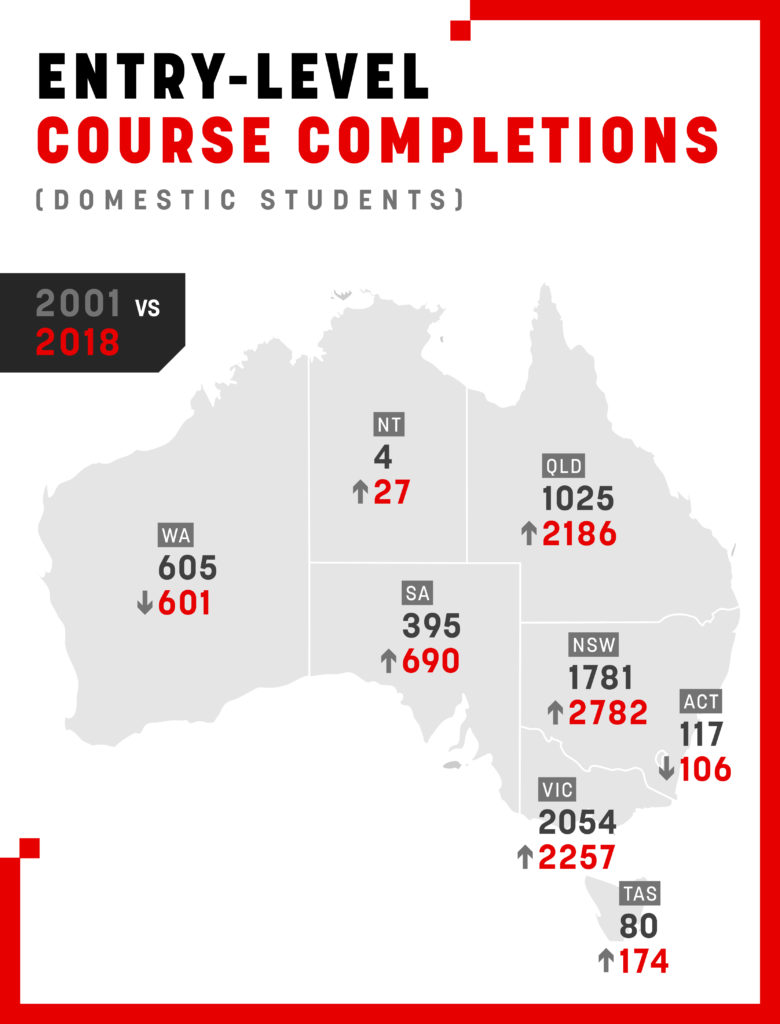A downward trend in the number of students enrolling in Australian university engineering courses may have turned, according to a recent report from Engineers Australia. But travel bans imposed to curb the spread of COVID-19 could affect revenue from overseas students.
Australia’s Next Generation of Engineers analyses the latest available higher education data (up to 2018) from the Commonwealth Department of Education and Training. It reports that overall entry-level commencements of engineering courses by domestic students grew by 3.8 per cent to reach 15,333 between 2017 and 2018. Across all course levels, domestic student commencements registered a smaller increase because post-graduate commencement fell.
Despite a fall in domestic student commencements between 2015 and 2017, completion of entry-level courses continued to rise – so much so, that they were the highest on record in 2018, with 8836 course completions.
The rise in enrolments was seen across six states and territories, and was most significant in New South Wales, Victoria and Queensland. Western Australia and the ACT both had slight declines. Civil engineering had the most graduates, followed by electrical/electronic and mechanical/industrial engineering – although some data was not clearly defined by course discipline.

Engineers Australia Policy Analyst Andre Kaspura told create that the decline in enrolments was probably due to a delayed reaction by students to reduced employment opportunities for engineers in resources and construction at the end of the mining boom in 2013.
“There can be a lag between what is happening in the real world and student adjustments,” he said.
Kaspura said tracking changes in domestic completions was important because Australian graduates account for around half of the nation’s engineering workforce, with the other half made up of skilled migrants.
But he added that multiple-year trends were more significant than yearly variations.
Effect of travel bans
In the 2017-18 financial year, Australian universities earned $31.9 billion from overseas enrolments. Kaspura said international student enrolment in Australian engineering courses has “skyrocketed” in the years since 2013, particularly in postgraduate Masters by Coursework programs.
In 2018, overseas students accounted for 33.4 per cent of entry-level engineering course commencements, 79.3 per cent of postgraduate commencements, and 53 per cent of overall course completions.
Kaspura said COVID-19 travel bans could have a significant impact on income from international engineering students, which has become increasingly important to universities as Federal Government funding has been frozen since 2017.
According to Professor Ian Burnett, President of the Australian Council of Engineering Deans, many international students are maintaining their current enrolments – either arriving in Australia before the travel bans took effect, or continuing their studies online.
In the longer term, Burnett said there were many uncertainties around the duration and nature of travel bans to Australia, making the impact on overseas students wishing to study engineering unclear.
“What is clear is that every Australian engineering university has worked hard to pivot to new remote learning models,” he added, explaining that this will put universities in a good position to offer education to both international and domestic students in a variety of circumstances.
Retention and gender balance are still challenges
In 2018, almost 2000 Australian women completed engineering courses. While the proportion of female graduates is still low (14.6 per cent), Kaspura said growth has been comparatively strong in recent years.
For example, in the decade to 2018 the number of female graduates increased by 620, while numbers remained static at around 1300 between 2001 and 2008. Course commencements by female domestic students also rose by 0.4 per cent to 18 per cent of total domestic commencements between 2017 and 2018.
Kaspura added that to speed this increase up further, workplace attitudes towards female engineers need to change more quickly.
“Acceptance of women engineers has improved only slowly, and there’s more room for improvement,” he explained.
While an apparent end to the decline in enrolments is welcome, Kaspura emphasised that retention of engineering graduates (and particularly female graduates) within the profession was still a key challenge.
